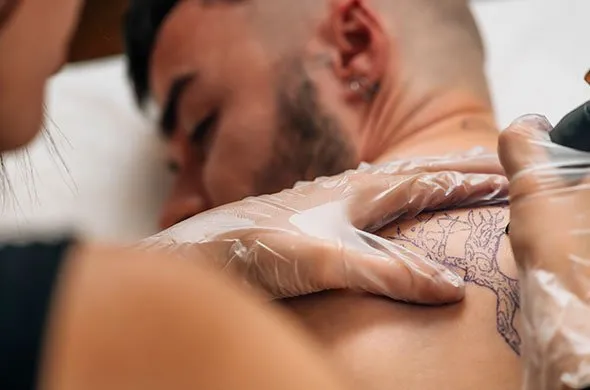Tattooing has been an ancient form of self-expression, a way to immortalize moments, beliefs, or loved ones. However, just as people evolve, so do their preferences. The rise of tattoo removal and cosmetic dermatology is a testament to this evolution, offering a second chance for those wishing to erase past decisions etched into their skin. Understanding the intersection and synergies between these two fields is crucial, not only for potential patients but also for professionals aiming to provide the best care possible. This article delves deep into this fascinating confluence, exploring how these domains interlace and enhance each other.
Overview of Tattoo Removal
Tattoo removal has come a long way since its inception. From primitive methods like salabrasion and acid treatments to sophisticated laser technologies, the journey is nothing short of revolutionary. Today, the most common methods include laser tattoo removal, dermabrasion, surgical excision, and chemical peels.
Laser tattoo removal is the gold standard, utilizing high-intensity light beams to break down tattoo pigments. The process involves several sessions, depending on the tattoo’s size, color, and depth. Despite its effectiveness, patients often face challenges such as pain, risk of scarring, and incomplete removal of certain colors.
Dermabrasion involves the mechanical sanding of the skin’s upper layers to remove the tattoo. While effective for small tattoos, it can be quite painful and often results in a lengthy recovery period.
Surgical excision is a more invasive method, where the tattooed skin is surgically removed, and the remaining skin is stitched back together. This technique is generally reserved for small tattoos due to the scarring it can cause.
Chemical peels use acidic solutions to remove the skin layers containing the tattoo. This method is less common due to its potential for causing significant skin irritation and uneven results.
Despite these challenges, advancements in technology continue to improve the efficacy and safety of tattoo removal methods, making it an increasingly viable option for many.
Understanding Cosmetic Dermatology
Cosmetic dermatology encompasses a broad range of procedures aimed at enhancing and rejuvenating the skin. Unlike medical dermatology, which focuses on treating skin diseases, cosmetic dermatology is all about aesthetics. Popular procedures in this field include Botox and fillers, chemical peels, laser treatments, and microneedling.
Botox and fillers are perhaps the most well-known procedures, used to smooth wrinkles and add volume to the face. Botox works by temporarily paralyzing muscles, preventing wrinkles from forming, while fillers plump up the skin to reduce the appearance of lines and hollows.
Chemical peels involve applying a solution to the skin that causes it to exfoliate and eventually peel off, revealing smoother and more youthful skin underneath. Different types of chemical peels target various skin concerns, from acne scars to hyperpigmentation.
Laser treatments cover a range of procedures, from laser resurfacing for skin rejuvenation to laser hair removal. These treatments use focused light energy to target specific skin issues, promoting collagen production and improving skin texture.
Microneedling involves creating tiny punctures in the skin using fine needles, stimulating the body’s natural healing process and boosting collagen and elastin production. This treatment is particularly effective for reducing scars, fine lines, and large pores.
Advances in cosmetic dermatology have made these procedures more accessible and effective, offering solutions for a wide range of skin concerns.
Intersection of Tattoo Removal and Cosmetic Dermatology
Tattoo removal and cosmetic dermatology share a significant overlap, particularly in the technologies and techniques used. The most apparent intersection is in the use of laser technology. Both fields rely heavily on lasers to achieve desired results, whether it’s breaking down tattoo pigments or resurfacing the skin.
Dermatologists are often at the forefront of tattoo removal procedures due to their extensive training and understanding of the skin. This expertise allows them to not only remove tattoos but also address any complications that may arise, such as scarring or skin discoloration. For instance, experts specializing in tattoo removal Melbourne utilize state-of-the-art laser technology to ensure precise and effective treatments, minimizing the risks of adverse effects.
Moreover, the principles of skin care and rejuvenation that underpin cosmetic dermatology are essential in the tattoo removal process. Post-tattoo removal, patients often require treatments that enhance skin healing and appearance, a need that cosmetic dermatology is well-equipped to meet.
Synergies Between Tattoo Removal and Cosmetic Dermatology
The synergy between tattoo removal and cosmetic dermatology lies in the ability to offer comprehensive care that addresses both the removal and the aftermath. Combined treatments can significantly enhance results, providing a holistic approach to skin care.
For instance, following laser tattoo removal, patients might undergo skin rejuvenation treatments such as laser resurfacing or chemical peels to improve skin texture and tone. These treatments can help mitigate any side effects of the tattoo removal process, such as pigmentation issues or scarring.
Additionally, addressing complications like keloid formation or hyperpigmentation can be managed with techniques from cosmetic dermatology, ensuring that the skin not only loses the tattoo but gains a rejuvenated appearance.
Case studies highlight numerous examples where the integration of both fields has led to superior outcomes. Patients have reported higher satisfaction when their treatment plan includes both tattoo removal and subsequent cosmetic dermatology procedures.
Patient Considerations and Best Practices
For patients considering tattoo removal, the journey starts with a thorough consultation process. It’s crucial to assess individual skin types, tattoo characteristics, and medical history to tailor the treatment plan effectively.
Pre-treatment care often involves preparing the skin with topical treatments to enhance the laser’s effectiveness. Post-treatment care is equally important, focusing on minimizing inflammation and promoting healing. This can include applying prescribed ointments, avoiding sun exposure, and following a skincare regimen tailored to the patient’s needs.
Choosing qualified professionals is paramount. Dermatologists and certified laser technicians bring the expertise required to navigate the complexities of tattoo removal and cosmetic dermatology. Their knowledge ensures that procedures are performed safely and effectively, minimizing risks and maximizing results.
Future Trends and Innovations
The future of tattoo removal and cosmetic dermatology is promising, with continuous advancements driving both fields forward. Emerging technologies, such as picosecond lasers, offer faster and more effective tattoo removal with fewer sessions required. These lasers deliver energy in ultra-short bursts, breaking down ink particles more efficiently.
In cosmetic dermatology, innovations like non-invasive body contouring and advanced skin tightening procedures are gaining popularity. The integration of artificial intelligence in treatment planning and personalized skincare regimens is also on the horizon, promising even more tailored and effective outcomes.
The convergence of these fields will likely see the development of new combined treatments that offer seamless transitions from tattoo removal to skin rejuvenation. As technology advances, so too will the ability to provide comprehensive care that addresses a wider range of skin concerns.
Conclusion
Tattoo removal and cosmetic dermatology are more interconnected than ever, creating a synergy that enhances the efficacy and satisfaction of both fields. As technologies and techniques evolve, the potential for integrated treatments that address both the removal and rejuvenation of the skin is immense.
Understanding this intersection is crucial for both patients and professionals, ensuring that the journey from tattooed to bare skin is as smooth and effective as possible. With continuous advancements on the horizon, the future holds exciting possibilities for those seeking to transform their skin and their lives.
In a world where change is constant, having the tools to adapt and reinvent oneself is invaluable. The interplay between tattoo removal and cosmetic dermatology offers just that, providing individuals with the opportunity to not only erase the past but also to embrace a renewed sense of self with confidence and clarity.
Keep an eye for more latest news & updates on Gossips!




